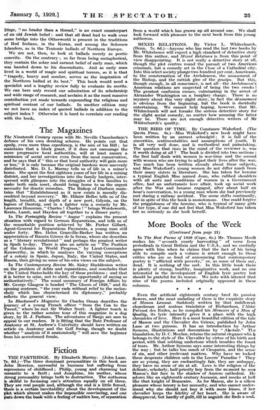Even the artificial eighteenth century bred its passion Sowers, and
the most unfading of these is the exquisite story of Marion Lem-aut. Suddenly written by that indifferent churchman and zealous translator of Richardson, l'Abbe Prevost des Exiles, as he compiled his Memoirs of a Man of Quality, its lyric intensity gives it a place with the high chronicles of love. Here is a most beautiful edition of the tale of Manon and the Chevalier des Grieux, published by John Lane at two guineas. It has an introduction by Arthur Symons, illustrations and decorations by " Alastair." The translation, by D. C. Moylan, retains the natural elegance whit h belongs to the style of the Chevalier by virtue of his birth and period, with that sobbing undertone which troubles the fount of tears. Mr. Arthur Symons says some interesting things by the way but he talks too much of Cleopatra, and the sense of sin, and other irrelevant matters. Why have we locked these desperate children safe in the Lovers' Paradise ? They are so young, they are enchantingly fair, they are unhappy, they have no sense of sin at all. Love is the religion of the delicate, scholarly, half-priestly boy froth the moment he sees Manon's fair face in the shadow of Amiens cathedral. He adores like an eighteenth century Aucassin, and mocks at hell like that knight of Beaucaire. As for Manon, she is a silken pleasure whose luxury is her necessity, and who cannot under- stand why she should not buy it with mere kisses, if her chevalier keeps the fidelity of her heart. She is aware of disapproval, but hardly of guilt, till in anguish she finds a soul. Never perhaps since Helen has a heroine so little described in detail left such an impression of a ravishing face. The fantastic gift of " Alastair " is most fortunately spent on the fine floriated drawings that ooneentrate the phases of this fugitive beauty. They are indeed In the Beardsley tradition, but fainter, drowsier, more excessive. The fragile pair are held in solemn whorls of sumptuous ornaments ; the effect has a note of the Spanish Baroque in it. Manon's small figure is lost in her great hieratic robes him a Madonna's ; des Grieux's soft mask of suffering has the bruised lids and hollowed temples of a San Sebastian. These red and black designs have a really extraordinary excitement and fascination. "The Closed Gate," to name but one, is a strange new pattern of beauty and despair. Endpapers, print, and other details are in harmony. This is a most satisfying edition of the immortal story.







































 Previous page
Previous page